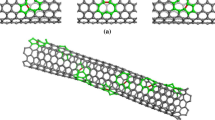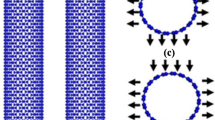Abstract
A methodology that accurately simulates the brittle behavior of epoxy polymers initiating at the molecular level due to bond elongation and subsequent bond dissociation is presented in this paper. The system investigated in this study comprises a combination of crystalline carbon nanotubes (CNTs) dispersed in epoxy polymer molecules. Molecular dynamics (MD) simulations are performed with an appropriate bond order-based force field to capture deformation-induced bond dissociation between atoms within the simulation volume. During deformation, the thermal vibration of molecules causes the elongated bonds to re-equilibrate; thus, the effect of mechanical deformation on bond elongation and scission cannot be captured effectively. This issue is overcome by deforming the simulation volume at zero temperature—a technique adopted from the concept of quasi-continuum and demonstrated successfully in the authors’ previous work. Results showed that a combination of MD deformation tests with ultra-high strain rates at near-zero temperatures provides a computationally efficient alternative for the study of bond dissociation phenomenon in amorphous epoxy polymer. In this paper, the ultra-high strain rate deformation approach is extended to the CNT-epoxy system at various CNT weight fractions and the corresponding bond disassociation energy extracted from the simulation volume is used as input to a low-fidelity continuum damage mechanics (CDM) model to demonstrate the bridging of length scales and to study matrix failure at the microscale. The material parameters for the classical CDM model are directly obtained from physics-based atomistic simulations, thus improving the accuracy of the multiscale approach.









Similar content being viewed by others
References
Zeng Q, Yu A, Lu G (2003) Molecular dynamics simulation of organic–inorganic nanocomposites: layering behavior and interlayer structure of organoclays. Chem Mater 15(25):4732–4738
Jancar J, Douglas J, Starr FW (2010) Current issues in research on structure–property relationships in polymer nanocomposites. Polymer 51(15):3321–3343
Koo B, Liu Y, Zou J (2014) Study of glass transition temperature (T g) of novel stress-sensitive composites using molecular dynamic simulation. Modell Simul Mater Sci Eng 22(6):065018
Subramanian N, Rai A, Chattopadhyay A (2015) Atomistically informed stochastic multiscale model to predict the behavior of carbon nanotube-enhanced nanocomposites. Carbon 94:661–672
Valavala P, Odegard G (2005) Modeling techniques for determination of mechanical properties of polymer nanocomposites. Rev Adv Mater Sci 9:34–44
Mott P, Argon A, Suter U (1993) Atomistic modelling of plastic deformation of glassy polymers. Philos Mag A 67(4):931–978
Rottler J, Barsky S, Robbins MO (2002) Cracks and crazes: on calculating the macroscopic fracture energy of glassy polymers from molecular simulations. Phys Rev Lett 89(14):148304
Rottler J, Robbins MO (2003) Molecular simulations of deformation and failure in bonds formed by glassy polymer adhesives. J Adhes Sci Technol 17(3):369–381
Lyulin A, Vorselaars B, Mazo M (2005) Strain softening and hardening of amorphous polymers: atomistic simulation of bulk mechanics and local dynamics. EPL (Europhys Lett) 71(4):618–624
Yashiro K, Ito T, Tomita Y (2003) Molecular dynamics simulation of deformation behavior in amorphous polymer: nucleation of chain entanglements and network structure under uniaxial tension. Int J Mech Sci 45(11):1863–1876
Roy S, Akepati A, Hayes N (2012) Multi-scale modeling of nano-particle reinforced polymers in the nonlinear regime. In: Proceedings of the 53nd AIAA-SDM Conference, Honolulu, HI
Panico M, Narayanan S, Brinson L (2010) Simulations of tensile failure in glassy polymers: effect of cross-link density. Modell Simul Mater Sci Eng 18(5):055005
De Borst R, Sluys L (1991) Localisation in a Cosserat continuum under static and dynamic loading conditions. Comput Methods Appl Mech Eng 90(1):805–827
Sayers C, Kachanov M (1991) A simple technique for finding effective elastic constants of cracked solids for arbitrary crack orientation statistics. Int J Solids Struct 27(6):671–680
Voyiadjis GZ, Kattan PI (2006) Damage mechanics with fabric tensors. Mech Adv Mater Struct 13(4):285–301
Shojaei A, Li G, Fish J (2014) Multi-scale constitutive modeling of ceramic matrix composites by continuum damage mechanics. Int J Solids Struct 51(23):4068–4081
Koo B, Subramanian N, Chattopadhyay A (2016) Molecular dynamics study of brittle fracture in epoxy-based thermoset polymer. Compos Part B Eng 95:433–439
Subramaniyan AK, Sun C (2008) Continuum interpretation of virial stress in molecular simulations. Int J Solids Struct 45(14):4340–4346
Plimpton S (1995) Fast parallel algorithms for short-range molecular dynamics. J Comput Phys 117(1):1–19
Jorgensen WL, Maxwell DS, Tirado-Rives J (1996) Development and testing of the OPLS all-atom force field on conformational energetics and properties of organic liquids. J Am Chem Soc 118(45):11225–11236
Zoete V, Cuendet MA, Grosdidier A (2011) SwissParam: a fast force field generation tool for small organic molecules. J Comput Chem 32(11):2359–2368
Van Duin AC, Dasgupta S, Lorant F (2001) ReaxFF: a reactive force field for hydrocarbons. J Phys Chem A 105(41):9396–9409
Chenoweth K, van Duin AC, Goddard WA (2008) ReaxFF reactive force field for molecular dynamics simulations of hydrocarbon oxidation. J Phys Chem A 112(5):1040–1053
Weismiller MR, Duin ACV, Lee J (2010) ReaxFF reactive force field development and applications for molecular dynamics simulations of ammonia borane dehydrogenation and combustion. J Phys Chem A 114(17):5485–5492
Singh SK, Srinivasan SG, Neek-Amal M (2013) Thermal properties of fluorinated graphene. Phys Rev B 87(10):104114
Mattsson TR, Lane JMD, Cochrane KR (2010) First-principles and classical molecular dynamics simulation of shocked polymers. Phys Rev B 81(5):054103
Wei C, Cho K, Srivastava D (2001) Chemical bonding of polymer on carbon nanotube. In: MRS Proceedings, vol 675. Cambridge University Press, Cambridge, pp W4. 7.1
Ebewele RO (2010) Polymer science and technology. CRC Press, Boca Raton
Lin-Vien D, Colthup NB, Fateley WG (1991) The handbook of infrared and Raman characteristic frequencies of organic molecules. Academic Press, San Diego
Miller R, Tadmor E, Phillips R (1998) Quasicontinuum simulation of fracture at the atomic scale. Modell Simul Mater Sci Eng 6(5):607–638
Zhao H, Aluru N (2010) Temperature and strain-rate dependent fracture strength of graphene. J Appl Phys 108(6):064321
Karger-Kocsis J (2000) Microstructural and molecular dependence of the work of fracture parameters in semicrystalline and amorphous polymer systems. Eur Struct Integr Soc 27:213–230
Tadmor EB, Ortiz M, Phillips R (1996) Quasicontinuum analysis of defects in solids. Philos Mag A 73(6):1529–1563
Basu A, Wen Q, Mao X (2011) Nonaffine displacements in flexible polymer networks. Macromolecules 44(6):1671–1679
Sommer J, Lay S (2002) Topological structure and nonaffine swelling of bimodal polymer networks. Macromolecules 35(26):9832–9843
Rai A, Subramanian N, Koo B (2016) Multiscale damage analysis of carbon nanotube nanocomposite using a continuum damage mechanics approach. J Compos Mater, 51(6):847–858
Acknowledgements
This research was funded by the Office of Naval Research (ONR), Grant Number: N00014-14-1-0068. The program manager is Mr. William Nickerson.
Author information
Authors and Affiliations
Corresponding author
Ethics declarations
Conflict of interest
The authors declare that they have no conflict of interest.
Rights and permissions
About this article
Cite this article
Subramanian, N., Koo, B., Rai, A. et al. Molecular dynamics-based multiscale damage initiation model for CNT/epoxy nanopolymers. J Mater Sci 53, 2604–2617 (2018). https://doi.org/10.1007/s10853-017-1733-y
Received:
Accepted:
Published:
Issue Date:
DOI: https://doi.org/10.1007/s10853-017-1733-y




